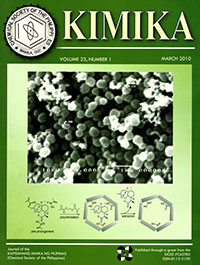Controlled Release of Methyl Salicylate in Chitosan-Poly(N-Isoporpylacrylamide) Semi-Interpenetrating Networks
DOI:
https://doi.org/10.26534/kimika.v23i1.26-31Keywords:
chitosan, methyl salicylateAbstract
A semi-interpenetrating network (semi-IPN) was produced by polymerizing N-isopropylacrylamide (NIPAAm) in the presence of chitosan and cross-linking agent, ethylene glycol dimethacrylate (EGDMA). The resulting material did not swell as much as poly(N-isopropylacrylamide) (pIPAAm), but still showed temperatute- and pH- responsiveness. Swelling and differential scanning calorimetry(DSC) experiments showed that the lower critical solution temperature (LCST) of the material was at 31 C. The semi-IPN was swollen below 30 C but started to collapse at this temperature. This is in the same range as the LCST of carrageenan-pIPAAm semi-IPN. The chitosan-pIPAAm semi-IPN was in a collapsed state and reached maximum swelling at pH 9 whereas pure pIPAAm and pure chitosan both became swollen at a lower pH.
Methyl salicylate was absorbed by the semi-IPN. Its release was monitored with respect to temperature. The temperature-responsive release of methyl salicylate was more pronounced at the LCST of 31 C.
Downloads
Published
How to Cite
Issue
Section
License
Authors who publish with this journal agree to the following terms:
- Authors retain copyright and grant the journal right of first publication with the work simultaneously licensed under a Creative Commons Attribution License that allows others to share the work with an acknowledgement of the work's authorship and initial publication in this journal.
- Authors are able to enter into separate, additional contractual arrangements for the non-exclusive distribution of the journal's published version of the work (e.g., post it to an institutional repository or publish it in a book), with an acknowledgement of its initial publication in this journal.
- Authors are permitted and encouraged to post their work online (e.g., in institutional repositories or on their website) prior to and during the submission process, as it can lead to productive exchanges, as well as earlier and greater citation of published work (See The Effect of Open Access).





